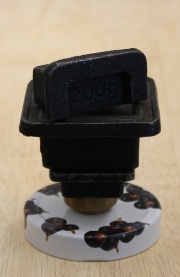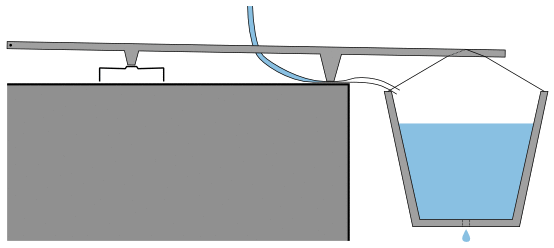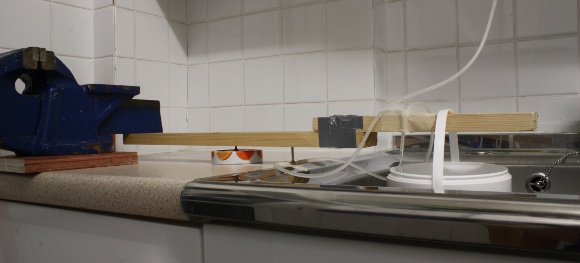An oscillator from a jam-jar lid

Fiddling with a jam-jar lid suggested its tamper-evident pop-up button exhibited hysteresis, and so I did some experiments on a blackcurrant jam lid to test this. Adding weight 50g at a time, the lid flexes very slightly, but stays popped up with 800g on top. It pops down when you add 50g to make 850g. Removing weight 50g at a time, the lid does not pop back up straight away. It stays down as you decrease the weight to 650g, but when you remove 50g to leave 600g, it pops back up. This confirms the suspected hysteresis.
I read a long time ago that if you take a system with hysteresis, and introduce negative feedback from the response to the rate of change of the controlling variable, then you get an oscillator. I wanted to demonstrate this idea in concrete terms with the jam-jar lid. I therefore needed to arrange for the force on the jam-jar lid to continually increase whenever the lid is popped up, and for the force to continually decrease whenever the lid is popped down.
Oscillator: theory
The system I came up with is built from a pivoted arm with a bucket hanging from the end. The bucket has a small hole in the bottom. A silicone tube supplies water to the bucket. Gaffer tape is involved. The arm has two studs underneath: one pressing on a jam-jar lid; the other ready to pinch the silicone tube against the table-top and stop the flow of water.
When the water supply is turned on, this should happen:

The system starts with an empty bucket, and the pivot arm up. Water flows through the tube, slowly filling the bucket (inflow via the silicone tube is quicker than outflow through the hole in the bucket). This makes the bucket heavier and heavier, pressing the left-hand stud down harder and harder on the jam-jar lid. Eventually, the stud is pressing hard enough to pop down the lid, the arm drops, and the right-hand stud cuts off the water.
Water now drains from bucket, making it slowly lighter, and making the left-hand stud press less and less hard on the jam-jar lid. Eventually, the force is small enough that the lid pops back up, the arm rises, the right-hand stud releases its pinch on the tube, water starts flowing again, and the cycle repeats. If there was no hysteresis, the system would settle down into a steady state with the lid partway down, and the tube partially squashed, such that the inflow matches the outflow.
The real system
When it came to build the actual system, I had a marmalade lid to hand instead, and with a bit of tweaking, got the oscillator to work. You have to watch quite closely to see the action; the arm moves just a tiny amount. The video runs twenty times real speed, otherwise it would be even less dramatic. There is no sound.
The graph in the bottom-right corner illustrates the hysteresis curve, with the blue dot showing the system’s currently state. It is not to scale, and is only meant to show the system’s behaviour in a broad sense.
Detail of pivot arm with screws for the two studs
The screws allowed adjustment of how hard the arm squeezed the tube when the arm was in its two positions, which are shown alternating here:
Whole system from another angle
